Ferry operator Stena Line celebrates today the 25th anniversary of its Dublin Port-Holyhead service – a quarter of a century that has seen the company carry in excess of 12 million passengers, almost 3 million cars and 3.5 million freight units on the route.
In 1995 the company traded as Stena Sealink with the first vessel to sail on the new Ireland-Wales service the Stena Traveller.
The route today is operated by the Stena Adventurer and the recently-built Stena Estrid, the first of three ‘next generation’ ferries commissioned for the Irish Sea, accommodating a mix of freight and leisure traffic.
Over the last 25 years, Stena Line has invested significantly in the Dublin to Holyhead route as volumes have increased significantly both in freight and leisure travel numbers. In fact, if all vehicles that have travelled with the operator to and from Dublin Port were laid end to end, they would circle the entire globe.
“The establishment of our Dublin Port-Holyhead operation 25 years ago today has been something of a game changer for us on the Irish Sea,” said Paul Grant, Stena Line Trade Director (Irish Sea).
“Holyhead has been a strategically important commercial gateway between Britain and Ireland for well over a century. Back in 1995 it was clear that Dublin Port was able to offer Stena Line the future expansion opportunities we required to help develop our business potential in the region, and that vision has now been rewarded.
“Today the service is one of Stena Line’s best performing Irish Sea routes which is why it was chosen to receive the first of the company’s three new build ferries, Stena Estrid, in January of this year. At 215 metres in length with a freight capacity of 3 100 lane meters, Stena Estrid also has the space to carry 120 cars and 1,000 passengers,” he added.
“However, no amount of foresight or planning could have factored in the devastating impact of the Covid 19 pandemic, but I am proud of the key role that Stena Line and my colleagues have played in helping to keep vital food and medical supply lines operational between Ireland and Britain throughout this crisis. We have worked hard to keep our guests and colleagues safe throughout this challenging time and are confident that the ferry industry will be one of the first sectors of the tourism sector to see a return to pre-Covid trading, when it is deemed safe to do so.
“As we move into 2021, Brexit will also provide a challenge for our business as it will for many others. We have been engaging constructively with authorities on both sides of the Irish Sea to ensure the free flow of goods through our ports and are assisting our freight customers as much as we can in their regulatory preparations for Brexit.
“As for the next 25 years, we have set a firm course on becoming the most sustainable global ferry operator, and I’m confident we have the vision and talent to achieve this ambition,” concluded Mr Grant.































































